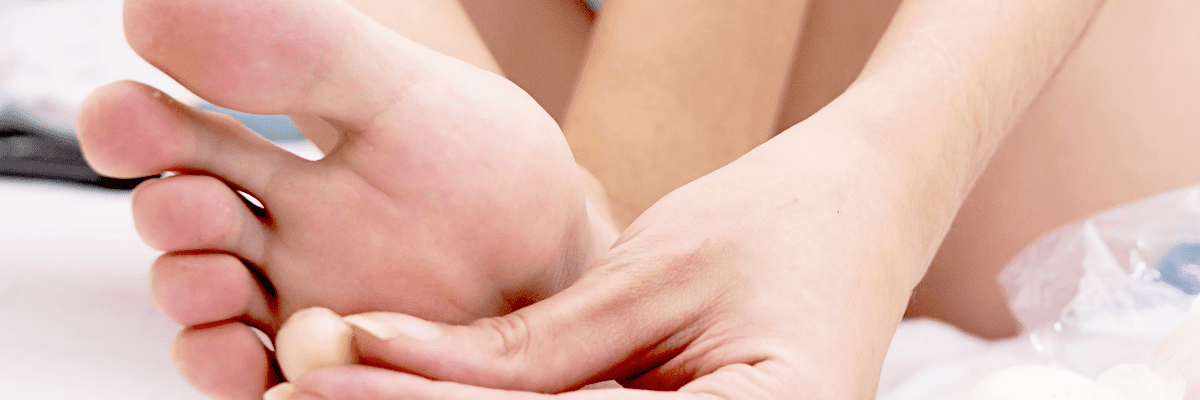
April 2024
This article provides an in-depth guide on how to get rid of verrucas, focusing particularly on how to remove a verruca root at home. The article will help you do the following –
1 – Grasp the importance of addressing verrucas promptly to prevent spread and discomfort.
2 – Learn about the various methods available for verruca removal, including home remedies and professional treatments.
3 – Discover the main causes of verrucas and how they develop to better understand the condition.
4 – Understand the benefits of effective verruca removal, including reduced pain and prevention of spreading.
5 – Encourage actions post-reading, such as adopting preventive measures and considering the most suitable verruca removal method.
1 – Verrucas, caused by the Human Papilloma Virus (HPV), often require effective verruca removal techniques to prevent spread and alleviate discomfort.
2 – Identifying a verruca correctly is crucial before considering how to get rid of verrucas.
3 – Removing a verruca root at home involves several steps, including soaking, exfoliating, and careful removal, but professional advice is recommended for persistent cases.
4 – Preventive measures, such as maintaining foot hygiene and using protective footwear in communal areas, are essential to avoid verruca infection.
5 – The article outlines various types of warts and verrucas, providing insights into their specific characteristics and treatment options.
6 – Advanced treatment options, including laser therapy and immunotherapy, offer alternatives for those with stubborn or recurrent verrucas.
7 – Consulting a healthcare professional is advised for severe cases or when home treatment methods fail to achieve verruca removal.
Warts and verrucas are skin conditions that can appear anywhere on the body but are usually found on the soles of the feet. A verruca tends to grow slowly and usually doesn’t cause any discomfort. In many cases, it doesn’t need to be treated unless it’s causing problems – e.g. if it is causing pain when wearing shoes or if the verruca has spread in many places around the foot.
It is important to know what verrucas look like to be able to identify them and seek treatment for them. Verrucas look similar to plantar warts, except they’re smooth and often a yellowy-brown colour when they mature. The tiny black dots on verrucas are small openings in the wart’s surface through which the human papillomavirus enters and leaves the wart. They can often be a distinguishing feature between verrucas and other types of warts.
Verrucas, also known as plantar warts, are caused by certain strains of the Human Papilloma Virus (HPV), particularly HPV types 1, 2, and 4. These viruses thrive in warm, moist environments, making the feet a common site for infection. The virus enters the skin through minor cuts or abrasions, often invisible to the naked eye.
Once HPV penetrates the outer layer of the skin, it causes rapid growth of cells on the outer layer of the skin, leading to the formation of a verruca. These growths are typically hard and flat, with a rough surface, and may have one or more black dots in the centre. The black dots are small blood vessels that have clotted.
The body’s immune system is crucial in how verrucas develop and eventually disappear. In many cases, the immune system will eventually clear the virus, leading to the natural disappearance of the verruca. However, this process can take several months or even years, as the immune system may not immediately recognise the virus.
HPV is highly contagious and can be spread through direct contact with a verruca or surfaces contaminated with the virus, such as floors in changing communal areas. Individuals with weakened immune systems or damaged skin on their feet are at a higher risk of developing verrucas.
Verrucas are most commonly located on the bottom of the foot, particularly between the toes. Still, they can also develop in other areas where skin rubs together – e.g., under fingernails and around hair follicles. This means that if you have a verruca, it can spread from one part of your foot to another if it’s not removed quickly enough.
There are several different types of warts and verrucas. These are detailed below, along with some information on treating them.
These skin-coloured warts normally appear on the hands or feet. They appear in clusters like large spots or bumps with rough surfaces. They sometimes bleed if knocked hard, although this is more likely with older warts that have gone deeper into your skin.
A common wart may eventually disappear independently or through some home treatment methods. Still, you should seek professional medical advice before attempting wart or verruca removal at home, as some methods can damage healthy skin when used incorrectly.
These occur most commonly in children between 5 and 15 years old who are often barefoot. The verruca appears as one or more lumps on the soles of the feet, which cause considerable discomfort when walking or standing for long periods. They can be very difficult to treat and may recur often.
It is best to visit a pharmacy for treatment advice as the pharmacist may recommend a range of treatments, but you should seek medical advice from your doctor before trying any self-treatment.
Plantar warts can be resistant to over-the-counter treatments that can be bought from pharmacies, and some of these treatments should not be used for children under 16.
Warts that appear on the genitals are called genital warts and are also caused by the HPV wart virus.
There is another lesser-known type of wart called mosaic warts. These are similar to plantar warts but tend to be smaller and may have more than one surface. Treatment is usually similar to that of plantar warts. If you are not sure which type of wart you have, it is best to seek advice from your doctor.
Preventing verrucas involves reducing the risk of contracting the HPV virus responsible for their development. Since verrucas are spread through direct contact with the HPV virus, often in moist environments where the virus thrives, taking preventative steps is crucial, especially in communal areas.
Maintaining good foot hygiene is essential in preventing verrucas. This includes regularly washing the feet, drying them thoroughly, and changing socks daily. It’s also advisable to avoid walking barefoot in communal areas such as changing rooms, showers, and around swimming pools.
Wearing flip-flops or pool shoes in communal showers, changing areas, and around pools can significantly reduce the risk of contracting verrucas. This barrier between the foot and the floor minimises direct contact with surfaces contaminated with the HPV virus.
Avoid sharing personal items that come into contact with the feet, such as towels, socks, and shoes. This reduces the risk of spreading the virus from one person to another.
Keeping the skin on your feet intact, without cuts or abrasions, can help prevent the HPV virus from entering the skin. Use moisturiser to keep the skin supple and reduce the chances of cracks forming, especially during colder months.
There is no evidence that verrucas are harmful in any way. They may cause some discomfort if left untreated, but they will not cause any long-term damage to your health. Some people may find them itchy or painful, and they may be a source of embarrassment for some people.
Some people may leave them alone if they cause no discomfort or are generally pain-free. The choice is always yours, but if the veruca is causing you problems, removing verrucas may help ease symptoms such as itching or discomfort when walking or standing.
Yes – they are caused by HPV, which can be transmitted between people through close skin-to-skin contact or in showers and swimming pools. It is crucial not to share shoes or socks with someone with a verruca. Also, keep your feet dry and clean to prevent getting or spreading the virus.
People often refer to verrucas as self-curing because they can sometimes disappear independently. This normally happens slowly without any treatment, usually within two to three years. Sometimes, it may take longer in people with a weakened immune system.
If the verruca has disappeared completely, it is unlikely that it will ever come back. But, if the verruca hasn’t disappeared after several months of trying self-treatment, you should make an appointment with your GP to ascertain whether further verruca treatment is necessary.
This section discusses how to remove a verruca root at home. Removing a verruca at home is possible; however, you could cause further damage to the skin or even cause an infection, so it is not necessarily the best way to get rid of verrucas.
Nevertheless, if you do want to learn how to remove a verruca root at home, you will need the following –
1 – A footbath (for soaking your feet)
2 – Foot scrub (sugar and soap can be used instead)
3 – Tweezers
4 – Pumice stone, nail file or emery board (optional)
5 – White vinegar (optional)
Soak your feet in warm water for around 15 minutes to soften the skin and make it easier to remove the wart. Dry your feet thoroughly before starting this process. If available, you can apply white vinegar to the area because it helps dry out warts faster; however, it is not essential.
A scrub can exfoliate excess hard skin, removing some of the verruca. Pumice stones or nail files can be used on the verruca but not on surrounding healthy skin, which may cause scarring or bleeding.
Pull off any dry pieces of skin with the tweezers. If you have an older verruca that is difficult to remove, soak it in white vinegar for around 5 minutes. Repeat until all of the verrucae have been removed. Apply antiseptic cream to reduce inflammation and prevent infection.
If you are unsuccessful at pulling out a verruca using these steps, seek treatment advice from your local GP.
When considering home treatments for verrucas, knowing their potential risks and limitations is important. While many home remedies and over-the-counter solutions offer convenience, they may not always be effective and could sometimes lead to complications if not used correctly.
Many home treatments, such as salicylic acid applications and freezing kits, have varying degrees of effectiveness. Factors such as the verruca’s size, depth, and location can influence the outcome. It’s crucial to acknowledge that these treatments may take several weeks or months to show results, and there’s no guarantee of complete removal.
Improper use of over-the-counter treatments can cause damage to the surrounding healthy skin. This is particularly true for treatments involving acids or freezing methods. It’s essential to follow the instructions carefully and to protect the area around the verruca to minimise the risk of irritation or burns.
Attempting to remove a verruca through cutting or other invasive methods at home poses a risk of infection. Any treatment that breaches the skin’s surface should be cautiously approached, and sterile techniques should be employed. Professional medical advice should be sought immediately if there’s any sign of infection, such as increased redness, swelling, or pain.
Certain individuals, including those with diabetes, poor circulation, or weakened immune systems, should be particularly cautious with home treatments. These groups are at a higher risk of complications and may require professional assessment and treatment to avoid adverse outcomes.
In summary, while home treatments for verrucas can be convenient, it’s important to use them carefully and be aware of their limitations. For persistent, large, or painful verrucas or any doubt about the appropriate treatment approach, consulting a healthcare professional is advisable.
In recent years, advancements in medical technology have led to the development of new and more effective treatments for verrucas. These options offer alternatives to traditional treatments, with some providing faster results and others targeting more stubborn or recurrent verrucas.
Laser therapy has emerged as a highly effective treatment for verrucas, particularly for those who are resistant to other forms of treatment. The laser targets and destroys the verruca tissue without damaging the surrounding skin. This method is precise, minimises the risk of scarring, and is often used for verrucas that have not responded to conventional treatments.
Immunotherapy is a novel approach that stimulates the immune system to fight the HPV virus causing the verruca. This treatment can be particularly useful for individuals with multiple verrucas, as it aims to treat the root cause rather than just the symptoms. Immunotherapy may involve the application of a chemical to the verruca to trigger an immune response.
Electrosurgery (burning) and curettage (scraping) can be performed under local anaesthesia to remove verrucas. This method involves using an electric needle to burn the verruca and then scraping it away. It is usually reserved for large or persistent verrucas and offers the benefit of immediate removal, although it may require a longer healing period.
Chemical peels using stronger acids than those available over the counter can be applied by healthcare professionals to treat verrucas. These peels work by exfoliating the layers of the verruca, allowing healthy skin to replace it. This treatment may require multiple sessions and is effective for single verrucas and clusters.
You can visit your pharmacist and ask for the best verruca treatment. These may include –
1 – Salicylic acid (removes dead skin cells from the affected area)
2 – Potassium hydroxide (destroys tissue)
3 – Aldara cream (helps replace damaged skin)
4 – Medicated plasters (protects the wart or verruca while applying active ingredients such as salicylic acid)
Your pharmacist will also tell you what to expect from these topical treatments. To prevent further irritation of the area, it may be beneficial to wear cotton socks or clean gloves at night after applying the medicine.
If the verruca is particularly severe and/or there is more than one verruca, it may be necessary to visit your GP for specialist treatment. After examination, your GP will decide on the best course of action and may refer you to a consultant dermatologist or podiatrist.
Podiatrists are specialist doctors trained in looking after the feet, and they carry out treatments such as cryotherapy, curettage and electrodesiccation. There’s also the option of laser therapy, which provides an alternative method of removing verrucas and wart using focused light beams that destroy cells in the wart or verruca area.
These may sound intimidating, but they normally do not cause much pain and can be carried out in one day. If you have many warts, you could also be prescribed anti-viral tablets, which reduce the symptoms and speed up recovery time.
Cryotherapy is carried out at a hospital by a GP or specialist nurse. The specialist will freeze the verruca using liquid nitrogen on a cotton bud and then cover it with padding to reduce discomfort. It may take a few weeks for the skin to heal after cryotherapy. Rest assured that this liquid nitrogen-based treatment process is safe for pregnant women.
Also known as excision removal, this is where your GP scrapes off layers of your skin (epidermis) with a surgical scalpel to destroy them and stop them from spreading under your skin. This surgical removal only affects the upper layers of the epidermis, so you will not be left with scars once healed. You can wear normal footwear afterwards, although this might hurt and cause bleeding.
This process involves burning away layers of your skin using an electric current, much like when an electric eel produces an electric current. There is usually no bleeding, but it does cause some discomfort and skin sensitivity afterwards.
This comprehensive guide offers valuable insights into verruca removal, detailing how to eliminate verrucas effectively and how to remove a verruca root at home. Critical pieces of information include –
1 – Understanding the causes and development of verrucas is essential for effective treatment and prevention.
2 – Correct identification and knowledge of verruca types can guide the selection of appropriate verruca removal methods.
3 – Home remedies may provide relief, but professional consultation is advised for persistent or severe verrucas.
4 – Preventive measures are crucial in reducing the risk of verruca infection and spread.
5 – Advanced medical treatments are available for challenging cases, offering hope for those struggling with recurrent verrucas.
6 – The role of pharmacists in providing initial treatment advice highlights the importance of accessible healthcare guidance.
7 – Seeking professional medical advice is recommended when home treatments fail or verrucas cause significant discomfort.
Pulling a verruca out with tweezers is not recommended, as it can lead to further infection or damage to the skin. Verrucas are caused by the HPV virus, and removing them physically can cause the virus to spread to other areas of the skin. It is safer to use treatments designed to treat the root cause of the verruca.
To get rid of verrucas fast at home, it’s important to use treatments that target the HPV virus and encourage the skin to heal. Over-the-counter solutions like salicylic acid or freezing sprays can be effective. Consistent treatment and good hygiene practices are key. Avoid trying to physically remove verrucas, as this can cause harm.
Cutting a verruca out is highly discouraged. This method poses a high risk of infection and can lead to scarring. Professional treatments are safer and target the verruca more effectively without damaging surrounding healthy skin.
The stages of verruca dying typically begin with the verruca changing colour, often turning black as the blood supply is cut off. Following this, the verruca may shrink and start to disappear. The process can vary in time and may require consistent treatment to fully resolve.
Understanding how to remove verrucas effectively involves using treatments that target the HPV virus, such as salicylic acid, freezing treatments, or professional medical options. It’s important to follow the treatment instructions carefully and maintain good foot hygiene to prevent the spread of the virus.
Pulling a verruca out with tweezers is not safe and can lead to further complications, such as infection or spreading the virus. It’s best to use clinically approved treatments that are designed to safely and effectively deal with verrucas.
If you can’t remove a verruca at home using over-the-counter treatments, it’s advisable to consult a healthcare professional. They can offer more advanced treatments like cryotherapy or laser therapy, which may be more effective, especially for stubborn verrucas.
Tom is a Content Writer and Editor for UK Care Guide, having previously acted as Head of Online for the Manchester Historian, and also the former editor for The Peterloo Institute.
Tom is a graduate of the University of Manchester with a BA (Hons) History degree.
His particular specialisms include writing on issues relating to later life (e.g. stairlifts, live-in care) and elderly care, having previously worked in a care capacity.














